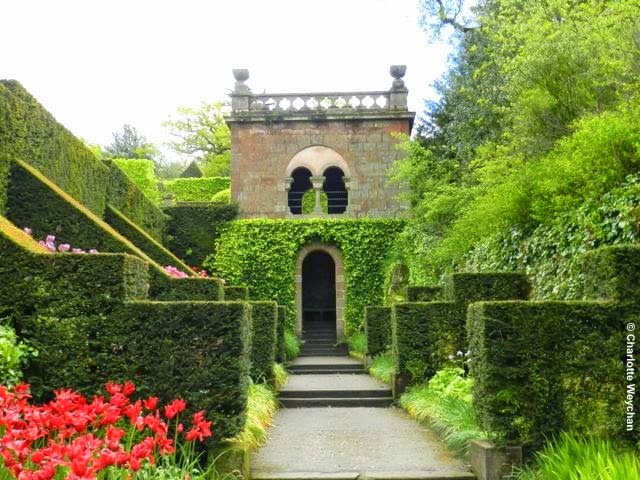Where plants of the world meet at England's heart - Biddulph Grange, Staffordshire
 |
| The Dahlia Walk at Biddulph Grange - planted with tulips in springtime |
Biddulph Grange in the heart of England is
a fine example of Victorian exoticism. The 26-acre site features 18 acres of formal gardens surrounding an Italianate mansion. James Bateman and his wife
Maria, both passionate and knowledgeable about plants, moved here in 1840 and built the extravagant house in place of a former
vicarage. Bateman and his close friend Edward Cooke then spent many years creating
the garden on the edge of wild moorland. But although the garden was famous in its day, its later use as a hospital led this much-admired garden into decline and it was only when it passed to the National Trust in 1988, that restoration work began.
 |
| The Italianate mansion at Biddulph Grange, built in 1840, is now divided into flats |
James Bateman was a wealthy local industrialist who thought nothing of spending a huge amount on his new home. But he was also a botanist and avid plant collector, so many of the plants and trees at Biddulph Grange were acquired from plant hunting expeditions to the Himalayas, which he sponsored. His garden grew as a result of his desire to showcase his ever-growing collection of plants from around the world, even though his personal passion was orchids. He was regarded as a leading orchidologist in his day, who produced the largest book ever written on them - a massive, 10-volume tome.
 |
| The Chinese bridge at Biddulph Grange in the heart of the garden |
The Chinese Garden (above) at the heart of Biddulph Grange is so well hidden that it is easy to miss! You can approach it via the Himalayan Glen through a dark tunnel and grotto, or at the base of the Egyptian garden, which takes you through the stumpery. Whichever route you take, you suddenly emerge inside the 'Great Wall' conceived by Bateman and Cooke and find yourself in a brightly-coloured foreign landscape, featuring a bridge and a temple, as well as gilded sculpture in the form of a water buffalo head. The planting here is all from the far East and you can expect spectacular autumn displays when the maples change colour.
 |
| Biddulph Grange is spectacular in springtime with its tulip and rhododendron displays |
Today Biddulph Grange is one of the most visited gardens in this part of England. Located in the heart of potteries country near Stoke-on-Trent, it is famous not just for its Chinese and Egyptian gardens, but also its international collection of plants. The result is a world garden, with an extraordinary landscape created by Bateman and Cooke featuring huge, imported rock formations, a series of tunnels, a Himalayan Glen and a stumpery. But this innovative approach to garden design, which includes 400 steps to link the different areas, also provides a sheltered climate for the plants growing there.
Much of the charm of this garden (apart from the extraordinary range of plants and trees on show) is the way that the various different areas are linked. The house is built on high ground and there is a steep gradient down to the gardens, so you suddenly find yourself at the mouth of a tunnel (above), or winding your way down irregular steps, uncertain where you are going, except for the areas adjacent to the house with the impressive parterre and Italianate gardens. And part of the element of surprise is emerging into a totally different landscape.
Biddulph Grange is open daily throughout the year (see NT website for times and prices) and is well worth visiting if you are in the area. Other notable gardens nearby include The Dorothy Clive Garden, (also spectacular in springtime, because of its rhododendron displays) and Wollerton Old Hall. At the time of writing, one of the nine apartments within the main house there is for sale, so if you fancy a garden of
monumental proportions on your doorstep, this may well be the place for you!




Victorian Britain's take on a whimsical garden!
ReplyDelete